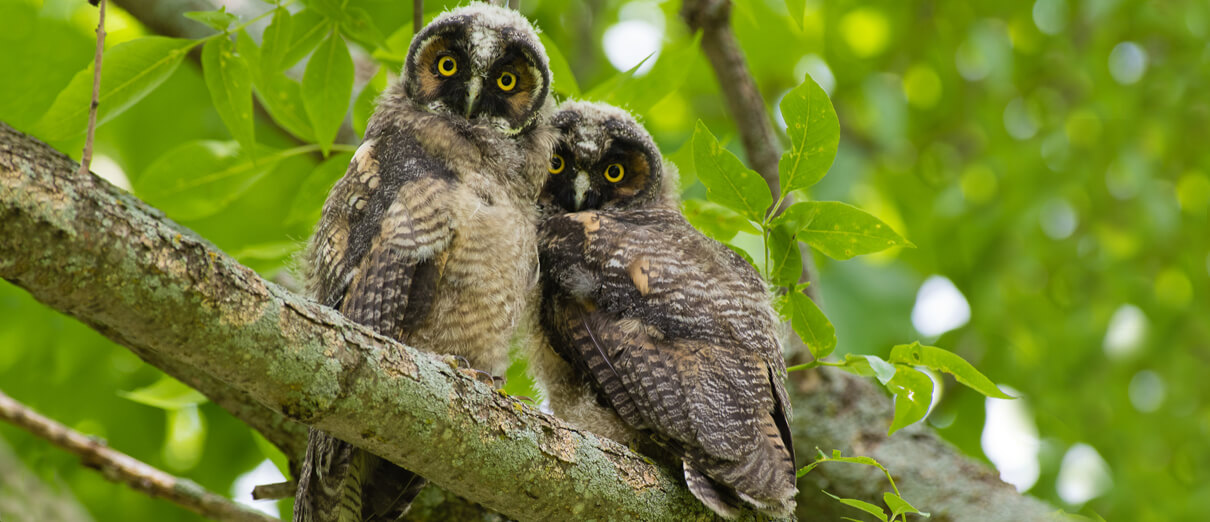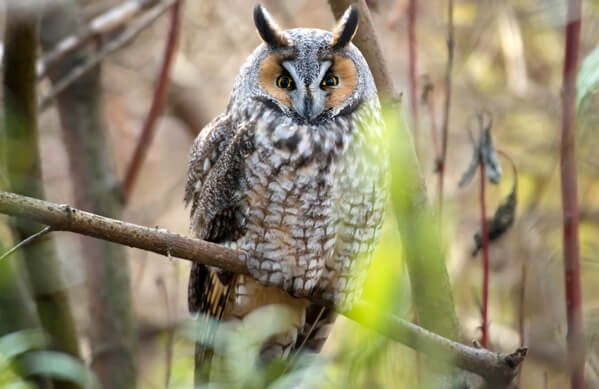
Long-eared Owl range map by American Bird Conservancy
The elusive Long-eared Owl, also known as the Lesser Horned Owl or Cat Owl, superficially resembles the Great Horned Owl but is much smaller and slimmer — in fact, it's North America's most slender owl. Distinguishing characteristics include long, close-set ear tufts (held flat to the head while in flight), an orange face punctuated by blackish highlights around the eyes, and dark streaking and barring on the undersides that creates a more checkered pattern than seen on the Great Horned.
This owl's sleek silhouette makes an effective defense against potential predators, allowing the bird to blend with its surroundings. It prefers to roost within dense foliage, often next to a tree trunk, where its slim body and dappled brown plumage render it practically invisible. When threatened, a Long-eared Owl further elongates its body, raises its ear tufts, and compresses its plumage, making it resemble a tree limb. This cryptic strategy is shared by other owls, as well as by the unrelated Common Potoo of Central and South America.
Safety in Numbers
The Long-eared Owl is unusually social for an owl. During winter, it can be found roosting in groups, from several to upwards of 20 individuals, although roosts as large as 100 have been recorded. These congregations are located within thick cover, where the birds are very difficult to detect. This uncommon sociability may help deter potential predators, including larger owls. Even during their breeding season, Long-eared Owls often nest in loose colonies, with pairs raising young within 40 to 50 feet of each other.
Widespread Owl
The Long-eared Owl can be found throughout the Northern Hemisphere, including from Western Europe to Russia, then as far east as Japan. In North America, it is found across southern Canada and from New England to the Southwest, including a few spots in northern Mexico. Isolated populations are also found in North and East Africa, the Azores, and the Canary Islands.
North American Long-eared Owls are partially migratory, with some birds moving south during harsh winters. Like the Snowy Owl, the Long-eared may also move in response to changes in food availability.
This owl is quite vocal during its breeding season, and makes a variety of sounds. The male Long-eared Owl gives an "advertisement" call — a repeated, resonant hoot that can be heard up to a mile away. The female responds with a raspier call. When alarmed, this owl shrieks and hisses, giving rise to one of its common folk names, "Cat Owl."
Listen here:
(Audio: Male hooting by Micah Riegner, XC233963. Accessible at www.xeno-canto.org/233963. Female hooting by Simon Elliott, XC592322. Accessible at www.xeno-canto.org/592322. Juvenile begging by Albert de Jong, XC327312. Accessible at www.xeno-canto.org/327312)
Dark Hunter
The Long-eared Owl feeds almost entirely on small mammals such as mice, voles, and ground squirrels. It occasionally takes small birds and reptiles as well. Like the Barn Owl, it hunts in complete darkness, foraging low and pinpointing its prey with its excellent hearing.
Its flight style is buoyant and moth-like, reminiscent of a Short-eared Owl, but the two species use different habitat types, with the Long-eared Owl favoring forest edge and open woods, and the Short-eared preferring open fields.

Long-eared Owl fledglings. Photo by Eric Preston
From Courtship to Dive-bombing Predators
Long-eared Owls begin to pair off on their winter roosts. A courting male uses calls and aerial displays to attract a mate; his repeated, resonant hoots can be heard at a great distance. Around the nesting area, the male performs a flight display that incorporates wing claps and zig-zag maneuvers.
The female usually chooses to lay her clutch of two to ten eggs in a stick nest abandoned by another bird. Occasionally, a female will nest in a tree or cliff cavity, in an abandoned squirrel nest, or even on the ground. The female incubates the eggs herself, although the male brings her food while she's on the nest. She continues to brood the newly hatched young until they are old enough to leave the nest.
If a predator approaches, adults defend their eggs or young by circling the nest and snapping their bills at the predator, or dive-bombing while making alarm calls. These owls may also feign injury in order to draw a predator away from the nest. In some cases, adults from nearby may join to perform defense displays when a single nest is threatened.
Conservation: Woodland Edges Are Key
Although not considered globally threatened, the Long-eared Owl is thought to be declining in North America, and was included on the 2016 State of North America's Birds Watch List. Habitat loss is the biggest threat to this owl, particularly the loss of grassland-forest edges, riparian woodlands, and isolated tree stands.
ABC's BirdScapes approach to conservation guides restoration of key habitats, including riparian stands used by the Long-eared Owl, the Southwestern Willow Flycatcher, and the western population of the Yellow-billed Cuckoo.
Donate to support ABC's conservation mission!



















































